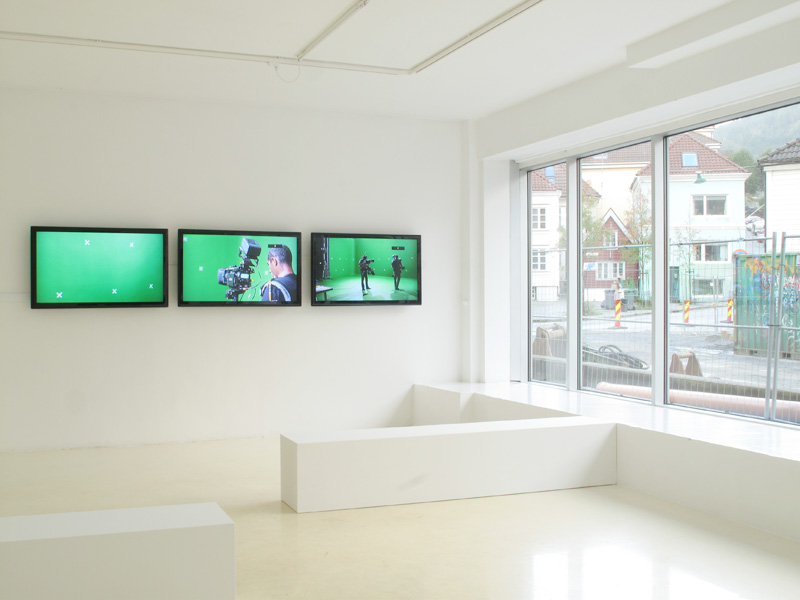Danilo Correale
We Are Making History

When the Lumière brothers screened their first short film, the impression of reality was so ‘new’ that when a train “arrives”, spectators are terrified by the locomotive that appears to be dashing towards them. Disbelief is suspended in favour of immersion into the fiction of the screen.
Danilo Correale further elaborates on the collapse of reality into hyperrealism as identified by Baudrillard in Symbolic Exchange and Death. The work shown at Entrée, We Are Making History, consists of a three-channel video that features a Chroma Key-equipped film studio, where the production rhetoric and the backstage itself are revealed. The viewers will face 'the image for what it is’, in what is now perceived as the standard definition of digital cinema.
Danilo Correale (b.1982) lives and works in Naples, Italy. We Are Making History was commissioned and shown at Manifesta 8. Correale has exhibited at The 11th Istanbul Biennal, Pistoletto Foundation, MADRE Contemporary Art Museum, Kunstraum Lakeside and Klagenfurth among other places. He`s been in residency at A.I.R. Antwerpen, Belgium and Mazama Residence, Seattle.
![]()
We Are Making History
by Danilo Correale
(…) Barry Levinson’s 1997 film, Wag the Dog, attempts to cope with the issue of public opinion manipulation through media control, enslaved to power. To distract the media and the American public from a sex scandal that involves the president of the United States, his PR officers, with the help of producer Stanley Motss, stage a fake war with Albania.
Images created in post-production are in fact those responsible for effecting the collective imaginary in a sharp and epic manner. The fiction inherent in video and the medium itself become an instrument for the falsification of reality, a reality that faithfully reflects the image we have of it. Today, the Green Screen is all that remains of a reality made unreal. You effectively no longer need any geographically traceable location: the digital reconstruction becomes a detailed orchestration of an image, a faithful and perfect reconstruction of a landscape that one whishes to make others believe has been ‘shot from life’.
The Chroma Key works for the artist as a "Tabula Rasa" in which everything can be recreated, the equipped film studio represents the paradigm of a system in which production and consumption do not answer a demand anymore, where even stories are built and sold as valuable immaterial goods.
We Are Making History also elaborate on the three concepts identified by Baudrillard in "Symbolic Exchange and Death" to describe three key historical periods: pre-modernity, modernity and post-modernity. These three concepts invest an image with meaning on the basis of the so called "law of value", thus we will have a first order of images called ‘counterfeition’, a second order named ‘production’ and a third order, namely, ‘simulation’. Baudrillard identifies in the third order the end of the classical meaning of reality: "this is the collapse of reality into hyperrealism, in the detailed reduplication of the real, possibly from another reproductive means, from medium to medium the real evaporates, it becomes real for real, fetishism of the lost object, no longer object of representation, but ecstasy of denial and of its own ritual extermination: hyperreal. "
Todays’ mediascape (what Arjun Apparudai defines as the landscape of images created of the world by electronic media) and the devices that surround us are pushing towards the establishing of a “hyper real” media scenario: it’s clear that since the ’60 television was no longer the privileged medium dedicated to information and reality but suddenly became the place where reality is created and at the same time legitimized.
Resolution, and its relationship with Participation is a fundamental theme of the project we’re making history, this is visible specifically in the choice of the technology/medium used. In We Are Making History the artist used a red 4k camera, which represents today’s state of the art digital cinema tool; a camera mostly used for Hollywood production and other blockbuster movies. The superior definition of the image which characterizes this camera is what often also characterizes our perception of television palimpsests and seems to have created a considerable distance between people and their natural need to actively participate in social struggle.
The underlying critique present in the project is about the progressive detachment from reality and its televised mirror, operated by the mass media through the recent and steep augmentation of definition of their contents.
Chronologically, if we look back to the 50s, TV was low def. and black and white, in the 70s the grain remained but color was introduced. Just two decades later, in the 90s, we saw digital TV becoming a standard, until recently, where Full HD is becoming more and more common; developing into what will presumably become a 3D home theater. The content of ‘reality’ will thus be transmitted to the viewer in his home finally marginalizing his social role completely. Foreseeing such a future, what could bring the viewer back into the streets?



Production still

